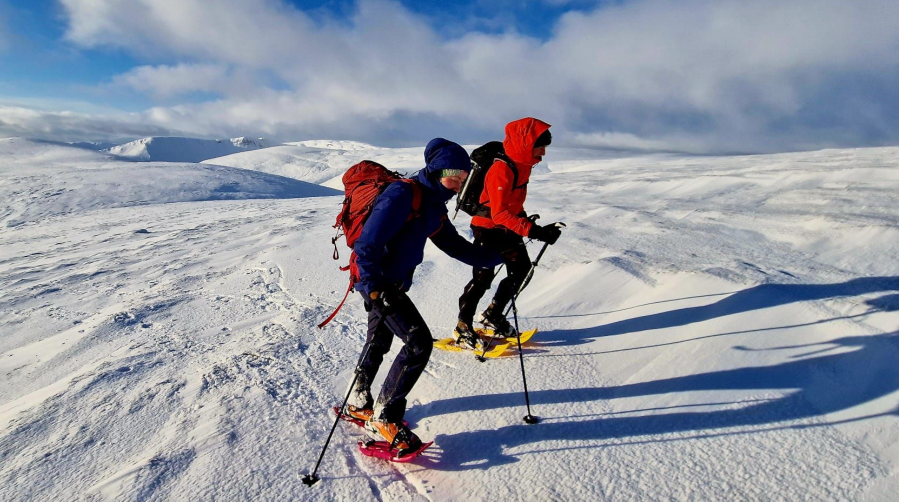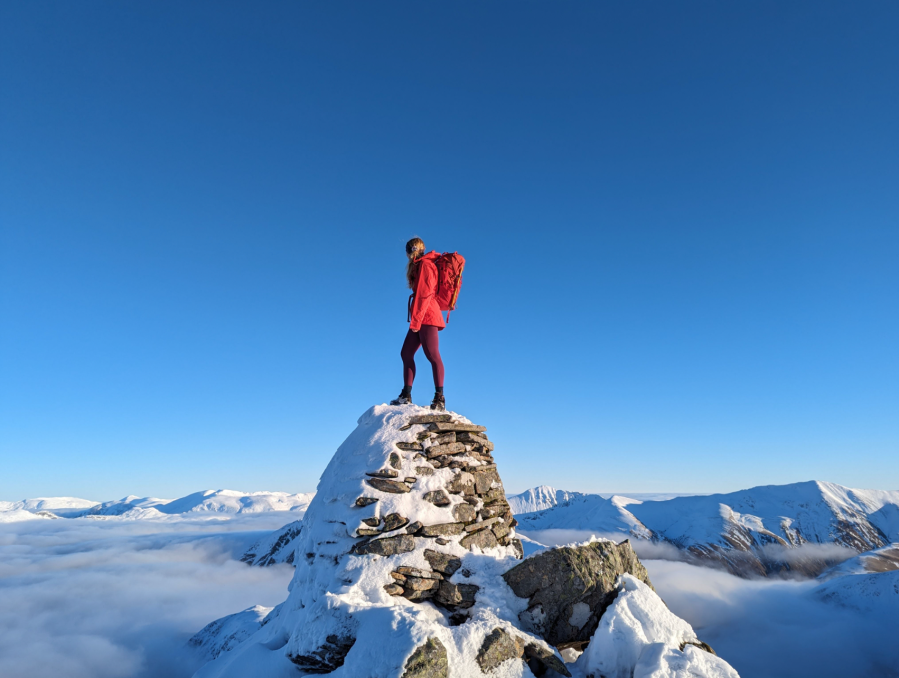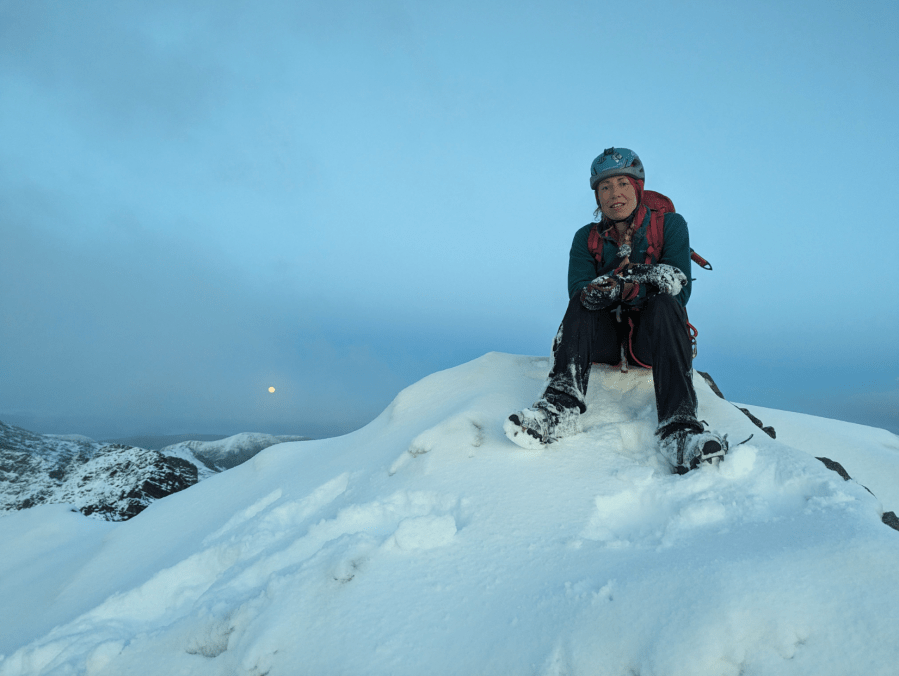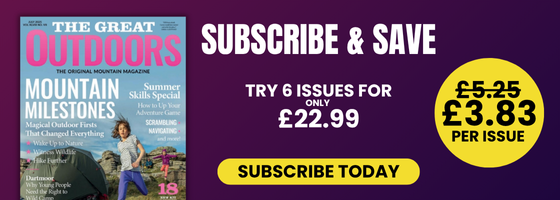This article on Anna Wells’ Winter Munro Round was first published in the December 2024 issue of The Great Outdoors magazine. Subscribe for more adventure inspiration and tales from the mountaintops.
Main image: A rare capture of Anna looking tired on her Winter Munro Round on Sgurr a’ Mhadaidh after a day climbing the southern eight Cuillin Munros in technical condition | Credit: Anna Wells
Snowflakes whipped around me, lit up by my headtorch in a dazzling and disorientating explosion of chaos. I brushed the frost off my compass with a clunky gloved hand so I could see the needle more clearly. In the wild, snowy darkness, my range of visibility was less than five metres. I chose another nearby target on my compass bearing, and carefully picked my way down through the icy boulder field, one agonisingly slow step at a time. I had been out for over sixteen hours and I still had three to go, but this was no moment to feel overwhelmed. I held myself firmly in the moment, knowing each step was one step closer. I reminded myself I was absolutely fine – warm, comfortable and on route. I felt emboldened and strong knowing that I could survive and thrive in these harsh conditions. That sense of self-sufficiency was the essence of what attracted me to the challenge in the first place.
On 13th March 2024 I became the third person and first woman to complete an entire Winter Munro Round in a single winter season. I climbed all 282 Munros in just 83 days, equalling the fastest time set by Martin Moran in 1985. My journey was full of dizzying highs, skipping along snowy ridges at sunrise with friends, and crushing blows, battling injuries, storms and long lonely nights. The pace and intensity of the challenge kept me focused and engaged, waking up almost every single morning buzzing with enthusiasm to be out in the mountains, and absolute gratitude to be spending my whole winter doing what I loved.
Highs and lows
The Cuillin Ridge on Skye was a major highlight. The rocky knife-edge ridge would have been easier to tackle without snow, but I was determined to climb the eleven Munros in “full winter condition”. It felt more authentic and would certainly be more fun. I kept constant tabs on the weather, ready to drop everything and head to Skye the moment the stars aligned. I struck gold with a beautiful blue-sky weekend and a foot of fresh snow; everything I dreamed of.
The following day, I climbed Ben Sgritheall alone with my paraglider and launched from the snowy summit. I flew down to Arnisdale with mind-blowing views across Loch Hourn to the snow-capped peaks of Knoydart. That same evening, I set off to climb two of the Kintail munros through the night; 26km and 1800m entirely in the dark. When conditions were good I overflowed with enthusiasm and my energy levels were enormous. I blasted around the mountains with motivation by the bucket load.
My Winter Munro Round: In Numbers
Duration: 83 days (67 hill days and 16 rest days)
Ascent: 141,141m / 463,061 feet
Distance: 1945km / 1208 miles
Number of days solo: 39
Days using a bike part of the way: 13
Number of car drops/lifts: 24
Number of nights hosted away from home: 30 houses (+ 2 bothy)
Lowest temp: -28 windchill
Highest winds: A day in Glencoe, 115kmph
Most number of Munros in a day: 10 (twice – Cairngorms and Mamores)
Curries consumed: 35
Cake consumed: over 100 pieces
Days snowshoeing: 6 days
Bagpipers bumped into: 1
White Christmas Days: 1
The weather dictated everything. I fought through multiple storms with ferocious winds, zero visibility and epic blizzards. I didn’t mind the bad weather because I knew it was a fundamental part of the experience – the endeavour being “hard” was exactly the point and I was there to embrace it.
The only thing that really, really got me down was injury. There were three occasions during my round where I was struck by significant foot or knee pain. Each time, I spent a couple of days hobbling around, catastrophizing that the winter was over. I struggled to accept that despite the monumental effort I was willing to put in, something out with my control might stop me. Fortunately, incredible physios came to my rescue and my body grew stronger. The tremendous sadness I felt during those moments of doubt reinforced just how important the project had become to me.
Another agenda
When I decided to attempt the Winter Munro Round, I hadn’t even contemplated my gender. It was only as an afterthought that I realised I would be the “first woman” and in truth, I simply felt fortunate that this gave my round a unique twist. This has been my perception of gender for much of my climbing and mountaineering life. I have consistently told myself that being a woman in a male-dominated environment has only ever brought me benefits – for example, greater recognition and sponsorship opportunities for accomplishments that would have been less remarkable if I was male.

I wrestled with the meaning of this. Were these achievements somehow actually harder for me as a woman, or was I just lucky to have ended up within a minority? WHY were women a minority? I struggled to understand, because for much of my life, I had been oblivious to any tangible barriers.
Yet throughout my Winter Munro Round, my gender clearly was a notable factor to other women. I was overwhelmed by the social media response. “Girl Power!”, “Super Women”, “Go Girl!”. “It’s International Women’s Day and you are truly inspirational!” Eventually, I understood – a huge part of the barrier was the lack of visibility. Perhaps it was less about a pathway being blocked or obstructed, and more about that pathway being altogether invisible. If women don’t see other women trying these things, it won’t fully appear on their radar, or seem like a place to belong. It sounds obvious now, but I’d never properly understood it before my round. I had always been so deeply immersed in the doing of adventurous stuff, and never walked in the shoes of an outsider.
I finally recognised my privilege – I am very lucky to have ended up with a strong sense of self-confidence and equality among my male peers. A combination of growing up with two brothers, and entering the world of mountaineering from competitive indoor climbing has possibly made me less gender conscious. It’s notable to me that this confidence isn’t always so apparent elsewhere in my life.
I left a career as a doctor because I did not have the confidence to trust my decisions, and I often struggle with self-esteem. Ask me to change someone’s medication and I will be an anxious wreck; send me onto a ridge in a blizzard and I’ll be cool as a cucumber!
Internal contradictions
Over hundreds of years, society has shown us that men belong in the mountains. The history of mountaineering is enormously male dominated, authors of climbing-related books are almost exclusively men, and movies propagate the image of hardy bearded adventurers. The message is so deeply ingrained that for years I didn’t even notice.

I have a memory of climbing in the Alps with my friend Dave. Although I was significantly more experienced and had led the whole route, a man at the carpark wanted to ask us route information, and addressed a question to my friend. Dave deferred the question to me, I responded, the man asked his next question to Dave, and the cycle continued. To be honest I didn’t even notice until Dave pointed it out.
On reflection, I can think of several similar occurrences. But even worse than these interactions where I was passively complicit with other peoples’ gender biases, I identified, to my horror, that I held them myself. If I meet a male-female duo on a winter climb, I realised that my default assumption is that the man is the more competent. Societal perceptions are so deeply engrained that I suspect most of us, male and female, all play a role in propagating them.

During the winter, I met a man on the summit of Ben Vorlich. He recognised me from social media and knew I was attempting the winter Munro Round. He asked if I’d done those four hills before (I hadn’t) and said “I think I will join you”, as a statement rather than a request, adding that he’d show me the way. He was dismissive of my plans, which added more distance but kept to good tracks, telling me “it’s fine cutting up the rough hillside if you know how to use crampons”. This interaction felt pretty patronising although it didn’t faze me personally, and my only concern was how I could politely remove myself from the situation to continue alone. Although likely well intentioned, I can see how this type of interaction might knock confidence and cause frustration.
Talking it through
Examining gender equality can feel quite fragile and loaded. After writing about a big challenging day in Glencoe, I received a comment on a social media post: “Absolutely incredible, what a feat of resilience, stamina and self-belief. Just so, so wonderful, and for me, even better because you are a woman. Way to go girl.” I read this as an entirely encouraging message, but a friend suggested it might be read as ‘women typically display less resilience, stamina and self-belief’. If the comment had been written by a woman it might have seemed inspiring and empowering, but because it was written by a man, it could be interpreted with a negative slant.

I struggled with this. It seemed as if women are allowed to acknowledge stereotypes and rise above them, but men get chastised. It’s a total minefield – surely, for things to move forward we should encourage more open dialogue. We need to foster an environment where people aren’t afraid to be supportive, with all genders working together in a well-intentioned way.
Recognising differences
On day 26 of my Munro Round, I struggled with an almighty crash in energy. Exhausted and emotional, I dragged myself around the Glen Lyon Munros in a whirlwind of tears and worries. The next morning I awoke to my period. My initial reaction was of great relief, that I could attribute my drained mental state to a temporary concoction of hormones. But as I walked around the mountains with a heavy fatigue and crippling tummy pain, it struck me that this was actually a significant extra element to contend with. If I got my period three times during the winter, then for about 15% of my Munro Round I could expect to be burdened with tiredness, fragile emotions and discomfort whilst battling extreme weather and big days.

Then there are the practicalities. Even peeing in the outdoors is trickier as a woman. Pulling down your trousers feels way more vulnerable than simply turning your back like guys can, and not only limits the options of ’appropriate’ places to go, but also exposes more skin to the elements – no joke in winter. Women also tend to use toilet paper when peeing, an extra piece of faff to deal with. In a blizzard, even the smallest task like stopping to put on a balaclava can feel like an overwhelming logistical challenge. So, imagine what it feels like to deal with a period, changing pads or tampons and sorting out personal hygiene whilst trying to stay warm and not letting all your kit blow away. At least one benefit of the Winter Munro Round was privacy – I rarely met anyone else!
During my round, I leaned on a number of strengths which might be considered more stereotypically feminine. Whilst my predecessors based themselves out of vans, I felt a strong pull for comfort and company in the evenings, seeking out warm beds each night. I was happy to ask for help, and greatly enjoyed meeting strangers around the country who made the entire winter infinitely more interesting and enjoyable. I love planning and organising, and believe my detail-oriented strategy was key to my success.

I also recognised that rest days seeing friends massively fuelled me up, and chose to do much bigger mountain days in exchange for more days off. Of course, it’s entirely debatable if any of these differences are down to gender, but I suppose my key message is that we should each figure out our own strengths and do things our own way.
See it to be it
The reaction to my Winter Munro Round opened my eyes to the issue of visibility and the importance of representing woman in mountaineering. The most heart-warming message I received was: “You are such an inspiration! I showed my seven-year-old daughter the news story about you and she said ‘That lady is so brave mummy! I hope I’m as brave as her when I’m older!’ I hope she has the grit and determination you have to succeed! Thank you for digging so deep!” The idea of inspiring other woman and a future generation feels like a massive privilege and an honour.
Realising the value of representation to others actually changed how I approached the second half of my round, encouraging me to do more days alone. Since most of my winter-mountaineering friends are male, I wondered if it might take away from the value if I was always going out with strong guys. From a safety and confidence perspective, I was indifferent as to whether I was alone or not, so decided to do lots more solo days in the company of audiobooks instead.

Looking to the future, I hope the mountains will be filled with lots more women and a more balanced attitude. The shift is already well underway in indoor climbing and summer hillwalking, and I hope it will filter through to winter and beyond. Talking about periods and peeing may feel awkward, but more dialogue makes these challenges far less intimidating and helps women share practical solutions. An important first step, I believe, is for us to recognise and admit that gender biases exist in most of us. Only then can we pro-actively challenge them. I spent much of my life oblivious to the impact of under-representation because I ended up ‘on the inside’, and I suspect many male mountaineers may not fully recognise how it feels to be ‘on the outside’.
We need to highlight the pathways into the sport and share stories about women being awesome in the mountains. Inspirational figures like Jasmine Paris (who completed the Barkley Marathons) and Jamie Aarons (who broke the fastest self-propelled Munro Round record) play a massive role in showing what women are capable of. And it’s just as important to celebrate every-day adventurers, not just the outliers, to shout the message loud and clear that we all have a place in the mountains.








